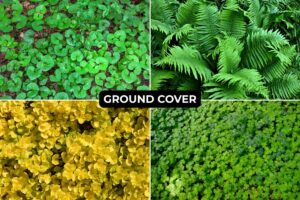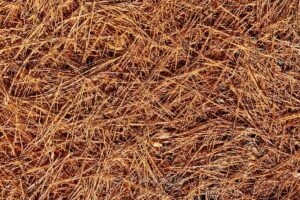This page may contain affiliate links. If you click and buy, we might get a small commission at no cost to you.
We all need a little shade in our backyards and tall shade trees are excellent for that. But, sometimes, they block the sun for the grass cover underneath as well. That’s where shade grass comes in. This variety of grass can thrive in areas with little sunlight and provide you with the ground cover you need to hang out in the shade.
So, what are the best shade grass for the climate where you live? In this article, we’re providing information on the best shade grass across 6 major U.S. regions with explanations why they will thrive in your area.
The best types of grass for shade in the 6 regions of the U.S.
1. Best types of grass for shade in the northeast
The northeast region of the U.S. includes New England and the mid-Atlantic states, which have a diverse climate ranging from semi-humid summers to extremely cold winters.
Grasses that do best in this region must be hardy to tolerate the humidity and cold. Below are 3 cool-season shade grasses that can thrive in the northeastern states.
Northeast states
- New Jersey
- New York
- Delaware
- Pennsylvania
- Connecticut
- Maine
- Massachusetts
- New Hampshire
- Rhode Island
- Vermont
Fine fescue
Fine fescue is one of the best grasses for dry and well-drained shade areas. While they are low-maintenance and establish fast, they don’t do well being walked on all the time and is more suitable for low foot-traffic areas. They have deep, extensive roots, meaning they can compete well being near tall trees and still find the nutrients they need to survive.
Tall fescue
For a resilient shade grass that stands up to heavy foot traffic, you’ll want to go with tall fescue. There are dwarf-type or turf-type tall fescue grasses and they can thrive in lawns getting only 4 hours of dappled or partial sun a day. This grass also grows well in poor soils and is drought tolerant.
Velvet bentgrass
If you want a bentgrass species, opt for the velvet bentgrass that is more shade-tolerant. This grass is low-growing and offers a cushiony, dense turf. It also does well in the humid and cool climate combo of the northeast.
2. South Atlantic U.S.
All the south Atlantic region states have very hot, humid summers, with winters ranging from cool and snowy to mild without snow. Being near the Atlantic coast, soils can be vulnerable to salt as well, so you’ll want to consider a grass that is tolerant to all these conditions. Below we have 3 examples.
South Atlantic states
- Florida
- Georgia
- Maryland
- North Carolina
- South Carolina
- Virginia
- Washington, D.C.
- West Virginia
Shoreline slender creeping
The shoreline slender creeping red fescue is a cool-season grass that is also extremely shade and heat tolerant. It has a fine texture, can handle high foot traffic, and does well with low maintenance. This variety is also unique since it combines the density of slender creeping red fescues with a salt-tolerant characteristic.
Blackwatch 2
The blackwatch 2 grass is a variety of tall fescue that’s dark green with semi-dwarf growth and low maintenance needed. It can thrive in hot or cold conditions and can easily recover from diseases or insects. This grass is also very shade and drought tolerant.
Sapphire St. Augustine
For warmer seasons or states with milder winters, like Florida, you’ll want to go with sapphire St. Augustine grass. This grass is one of the more shade-tolerant varieties of St. Augustine that offers a soft, thin-bladed ground cover. It also holds up well against salt in the soil or even when getting saltwater sprayed on it.
3. South Central U.S.
West and east south central states make up this region where the climate is less extreme than others. One common factor across all the states is heat. You’ll want warm-season grass that is tolerant to high heat and areas of humidity like one of the 3 options below.
South central states
- Arkansas
- Louisiana
- Oklahoma
- Texas
- Alabama
- Kentucky
- Mississippi
- Tennessee
Palmetto St. Augustine
For an all-around durable grass that grows best in this region, go for the palmetto St. Augustine grass. Besides being shade-tolerant, it can also withstand high heat and drought conditions as well as recover quickly from high foot traffic. It’s also more cold-tolerant for a warm-season grass variety since it will remain green even after experiencing frost.
Korean velvet grass
Another sturdy grass cover that does well in this region is the Korean velvet grass. This zoysia species can tolerate full shade areas and thrives in the heat and humidity.
If conditions are too hot or drought-heavy, this grass will go dormant and spring back to life again after being watered. It can also stand up to heavy foot traffic.
Carpet grass
If you live in a humid area with wetter ground, you’ll want to consider carpet grass. This low-growing, coarse turfgrass can thrive in wet, boggy soils. It survives well in the coastal regions of Texas and the acidic sandy soils of Mississippi. However, it does require some sunlight and grows best in partial shade areas without drought.
4. Mid-west U.S.
The midwest region includes both east and west north-central states and has an overall humid continental climate. However, you’ll also see a big difference between summer and winter temperatures. With hot days and below-freezing winters, you’ll want a grass that can survive these ranging conditions.
Midwest states
- Illinois
- Indiana
- Michigan
- Ohio
- Wisconsin
- Iowa
- Kansas
- Minnesota
- Missouri
- Nebraska
- North Dakota
- South Dakota
Hard fescue
Hard fescue is the most heat-tolerant of the fine fescue cool-season grasses. It is also more drought and disease-tolerant and often found in seed mixes to improve durability.
This low-maintenance, shade-loving grass will be able to withstand the cold winters and hot summers. However, it’s best to plant them in early spring or late August and mid-September before the soil reaches 50 degrees Fahrenheit.
Turf-type tall fescue
The turf-type tall fescue is an overall durable cool-season grass cover that will remain green 8 to 9 months out of the year. They have deep toots that make them drought-resistant and are sturdy against disease and high-foot traffic. This grass also does well in shaded areas, heat, and cold, making it a great option for this region.
Perennial Ryegrass
If you want finely-textured dark green grass that stands up to high foot traffic, you’ll want to consider perennial ryegrass. This grass can grow in the mid-west region’s average highs and tolerates temperatures below freezing or even survive under snow cover. Although the most shade-tolerant ryegrass variety, it does best in partial shade with at least 4 to 5 hours of partial sun.
5. Mountain West
The mountain west region of the U.S. has one of the most diverse climates, although most of the states are arid to semi-arid. Meaning, you’ll want reasonably drought-tolerant grass.
As the region’s name suggests, there are also mountainous areas with alpine climates that get cold and have low nitrogen in the soil. Below are 3 examples of drought-tolerant grasses and varieties requiring low nitrogen levels.
Mountain west states
- Arizona
- Colorado
- Idaho
- Montana
- Nevada
- New Mexico
- Utah
- Wyoming
El toro zoysia
The el toro zoysia has the highest tolerance to drought out of the zoysia varieties. It does well in the shade, is easy to maintain, and requires less nitrogen than other grasses.
This dense, medium green grass can also withstand high foot traffic and choke out weeds as it spreads. Although a warm-season grass, it is also known to be more cold-hardy and survive winters below freezing.
Argentine bahiagrass
Argentine bahiagrass is extremely heat and drought tolerant and can thrive in areas most other grasses can’t. It has a darker green shade and is tough enough to withstand foot traffic. While the Argentine variety is the most shade tolerant of all bahiagrasses, they still do best in partially shaded areas.
Chewings fescue
As a cool-season grass, the chewings fescue can tolerate temperatures dropping to 14 degrees Fahrenheit. They can also produce a quality green even with substantially less nitrogen, making them optimal for high altitudes. While they are extremely shade tolerant, they aren’t recommended for high-traffic areas since they recover slower from wear and tear.
6. Pacific west
The pacific west region includes all the states located by or surrounded by the Pacific ocean, making this region mostly wet and cool with coastal climates.
However, the region also has sunny, dry climates of southern California and tropical habitats of Hawaii. Depending on which state you’re in, you’ll want one of the 3 types of grass detailed below.
Pacific west states
- Alaska
- California
- Hawaii
- Oregon
- Washington
Sheep fescue
The sheep fescue grass variety has the best heat tolerance among fine fescues. This cool-season shade grass has fine textures and slow growth habits but is ideal for any state in the Pacific west because of its tolerance to harsh conditions and temperature extremes. It will thrive in the heat and drought of southern California or cold winters of Washington.
Diamond zoysia
Diamond zoysia grass is a low-maintenance and low-growing grass with a fine, soft texture. It is resistant to insects and diseases you can commonly find in this region. It is also quite aggressive and will spread easily and choke out weeds.
This grass is great for salty, coastal soils and low light conditions. It can withstand normal foot traffic and its dense growth recovers from damage similar to other zoysias.
Poa supina
For the colder weather of states like Alaska or for states that have low-temperature winters, you’ll want to use poa supina grass. This cold and shade tolerant grass is also wear-resistant, making it great for high foot-traffic areas.
It has high shoots and is a fine-textured turf grass that does very well in dense shade. You can also mix it with rough bluegrass for added durability.



